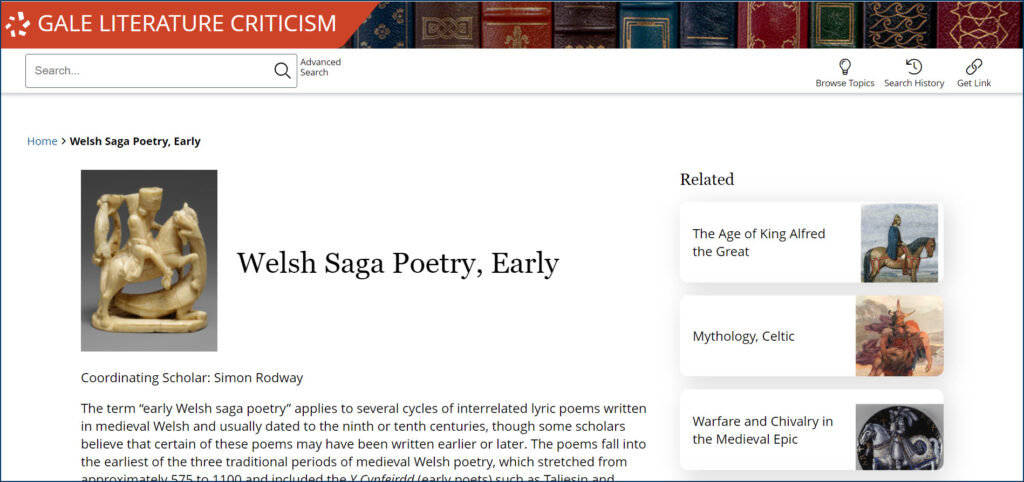| By Gale Staff |
April 2024 marks the 28th anniversary of National Poetry Month, a celebration established by the Academy of American Poets with six goals in mind:
- Highlight the extraordinary legacy and ongoing achievement of American poets.
- Encourage the reading of poems.
- Assist teachers in bringing poetry into their classrooms.
- Increase the attention paid to poetry by national and local media.
- Encourage increased publication and distribution of poetry books.
- Encourage support for poets and poetry.
At the university level, students have a little more life experience under their belt, making it a more meaningful experience to tuck into a particularly succulent piece of poetry. However, they also require a bevy of resources to support that voracious appetite for verse. Gale Literature Criticism is the right tool for the job, whether they’re engaging with the works of Plath, Poe, Lourde, or Longfellow.
When your university library offers access to Gale Literature Criticism, students can tap into the most extensive collection of literary commentary available, consisting of nearly 75,000 entries, spanning the gamut from diary entries to analyses and reviews across 53 different styles of poetry.
Best of all, it’s delivered in a user-friendly interface that makes those all-nighters go a lot faster by saving students precious time hunting down rare content.
Spark Campus-Wide Interest in Poetry With Gale Literature Criticism
Regardless of major, every university student will engage with poetry at some point in their academic career—and that exposure matters. When students work with poetry as an art form, they engage in creative expression, critical analysis, and a sense of oneness with the human experience. Even those who spend most of their days in the engineering lab or business classes can benefit from spending some time entrenched in prosody.
As Professor Devon Miller-Duggan of the University of Delaware English Department puts it, “Scientists are very linear in how they’re trained . . . The problem is that the world doesn’t work that way. It’s not a straight line. So, giving them the opportunity to function in zigzags and leaps is ultimately going to benefit their capacity to function as scientists and to trust their instincts.”
Bridge the gap across majors by making poetry more accessible for everyone with Gale Literature Criticism. We offer our collection in an interactive digital platform that makes it far easier to find topics, works, or authors that interest the student with a simple search—no dusty tomes required.
Gale Literature Criticism also empowers college librarians to celebrate the art of poetry all year long, thanks to scores of resources that offer limitless opportunities to showcase just how much the genre has to offer.
To that end, we’d like to show you how you can use the Gale database to foster a community of poetic discourse not just during National Poetry Month, but all year long.
Digital Exhibitions
Busy college students don’t always have time to squeeze a trip to the library into their busy schedules. Still, a digital exhibition of a particular topic, complete with multimedia content and further reading resources from Gale Literature Criticism, allows students to engage with the content on their own schedule.
This database eliminates the need to dig through random search results to create your digital exhibition. You can trust that Gale provides high-quality, thoroughly vetted content, helpfully categorized into 53 styles, from Early Welsh Saga Poetry to the Japanese Kokinshu.

For the sake of showing you just what Gale’s database has to offer, let’s use “Nonsense Verse” as an example. Once on the topic page, you’ll find an overview that explains how the genre “carefully combines aspects of the rational with the irrational to create a playfully incongruous mesh of language.” Along with the overview, you will find 77 critical works, and a sidebar of related topics, including Lewis Carroll, Theodor Seuss Geisel, and Children’s Poetry, all from one easy-to-use hub.
From there, you can curate a bibliography of the most interesting scholarly and popular commentary on nonsense verse, which could include:
- “Review of the Nursery Rhyme Picture Book” (1913) is a tongue-in-cheek assessment of a contemporary collection of nursery rhymes that notes, “As a rule, these books are simply portrayals of the child mind. The child cares nothing for them; the humour passes him by . . . and the illustrations are wonderful.” Pair with a selection of illustrated nursery rhymes from the era.
- “Child Poets and the Poetry for the Playground“ (2004) by Joseph T. Thomas Jr, where he argues that the refusal to include playground poetry in the category of children’s poetry is an affront, as these short rhymes, chants, and songs that often accompany a game or set of movements “belong to a rich poetic tradition.” Embed examples of playground poetry, many likely familiar to college students. How many do you recognize from your childhood years? You might be surprised!
- “A.A. Milne and Today’s Seven-Year-Olds” (1962), in which Ethel and Agnes G. Gunderson study how students of that time relate to two of Milne’s books of poetry: When We Were Very Young from 1924 and Now We Are Six from 1927. Forty years after their publication, the Gundersons concluded that “it is Milne’s understanding of children and of their world; his ability to see and present children as they are that account for the [generational] appeal of his poems.” Well, now it’s been a hundred years. Test their theory with an online poll that asks students whether they, too, enjoyed the author’s works as children.
With Gale Literature Criticism, it’s far easier for your college library staff to tap into these resources and thousands of others that enrich students’ experience of poetry through diverse perspectives.
Couple that with your multimedia and interactive content selection, and you’re sure to draw in a whole new crowd of poetry enthusiasts.
Interdisciplinary Showcases
As the flowers unfurl their buds and the first blades of green crack through the frozen ground, nature’s reawakening also seems to stir our appetite for observing the world with renewed wonder.
What better time than spring—the same season in which National Poetry Month takes place—to appreciate the imagery and emotions poetry evokes?
Invite your university art department to participate in an interdisciplinary showcase in which students create a piece of visual art in their preferred medium to reflect a particular movement, such as French Symbolist Poetry.
This late 19th-century style “[was] characterized by a concern with moods and transient sensations rather than lucid statements and descriptions,” making it an intriguing prompt for artists who must be able to interpret the piece’s ambiguity into something tangible.
Gale Literature Criticism provides all the background that students need, along with translation and text-to-speech options to ensure that artists can easily access these rich resources, including:
- “The Poetry of Symbolism and Decadence” (2000) is a piece by Clive Scott in which he goes into intensive detail about Symbolism’s concern to “activate the memories, associations, and unconscious impulses of the individual, as well as of the culture. . . To paint not the thing, but the effect it produces.”
- “In a Letter to Émile Verhaeren on January 22, 1888,” from the private collection of Stéphane Mallarmé, one of the most important figures of the French Symbolist movement. His letter praises Verhaeren’s early works for their focus on “philosophical despair, hallucinatory imagery, extraordinary mental states, and verbal experimentation.”
- “To Plunge into the Bottom of the Abyss’: Rimbaud’s Search for the Unknown in the Drunken Boat and Memory” (1978), wherein Enid Rhodes Peschel describes Rimbaud’s “masked, elusive quality of his utterances; the primordial importance he ascribed to the symbol rather than to the direct statement; his use of synesthesia; and his haunting, lyrical musicality.”

Only Gale Literature Criticism can offer such an extensive collection of primary source documents, contemporary and modern poetry reviews, and in-depth analyses–more than 700 just about French Symbolist Poetry! Fine arts students will appreciate the opportunity to get inspiration for a piece directly from the poets and the critics, scholars, contemporaries, and friends who knew them best.
Partner With Gale to Celebrate National Poetry Month at Your University Library
We hope that these ideas for using Gale Literature Criticism have inspired you to celebrate National Poetry Month—this year and every year! Even if poetry isn’t on your radar, there’s still plenty to love about Gale’s databases and their interdisciplinary possibilities. Our materials span and unite disciplines across the humanities, arts, sciences, history, and more.
If you’re ready to learn more about this award-winning collection and its value for your university library, reach out to your local rep!

